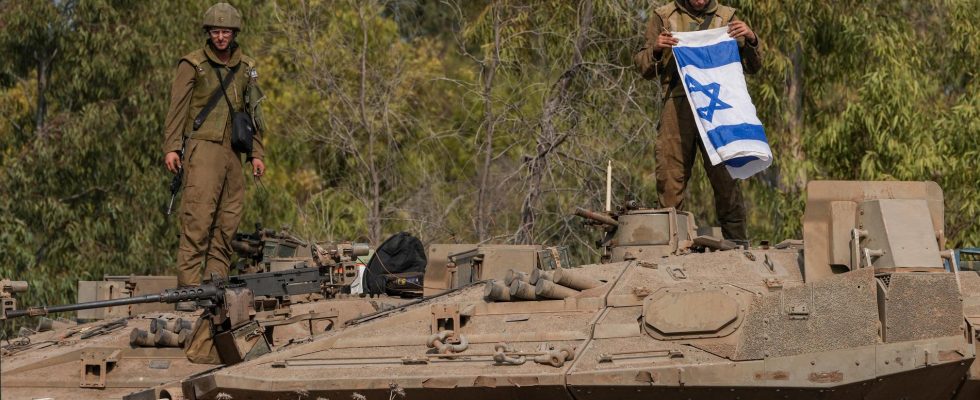Save the article
1 / 3Photo: Tsafrir Abayov/AP/TT
More than 700 people have been killed in Israel in the large-scale offensive by Hamas, branded as a terrorist.
The synchronized attack is being called the worst in the country in 50 years – but why was it launched just last Saturday? And how will Israel respond to the attack?
TT investigates with two experts.
The fact that the Islamist terror-labeled organization Hamas chose to launch its offensive precisely on Saturday morning could have several reasons, says Magnus Ranstorp, terrorism researcher at the Norwegian Defense University.
– The Israeli Defense Force IDF has moved almost 70 percent of its forces to the West Bank. This means that the ground in Gaza was quite thin, and after Hamas managed to cut off communications, the units that were there could not communicate with each other either, he says.
Hamas now wants to start a war on several fronts, according to Ranstorp.
– In addition, they want to sabotage the ongoing normalization talks between Saudi and Israel, he says.
According to Anders Persson, Israel expert and researcher at Linnaeus University, Hamas has given two explanations for the attack.
– Partly they have said that they want to protect the al-Aqsa mosque in Jerusalem, and partly that they want to end the Israeli state, he says and adds:
– A partial aim may also be to overturn Israel’s normalization attempts with Saudi Arabia.
What is Hamas?
The Islamist organization Hamas took control of the Gaza Strip in 2007. The organization’s management consists of a committee of 15 people, and they also have cells in the West Bank, says Magnus Ranstorp.
– Hamas is a militant Sunni Islamist movement with three branches: a military, a social and a political branch. The organization’s goal is to establish an Islamist state and to wipe out Israel, he continues.
Anders Persson states that Saturday’s attack can be seen as a major blow in Hamas’ eternal war against Israel.
– We now hope to involve several parties and create a chain effect, he says.
How big is the support for Hamas?
About two million people live in the Gaza Strip, which is located on the southeastern corner of the Mediterranean Sea, with a short border with Egypt to the south.
According to Magnus Ranstorp, support for Hamas is large among the area’s residents.
– The more Gaza has been isolated, the more the population has been radicalized. Hamas stands for the Islamic resistance movement. And the resistance takes place in the political, social and military arena, he says.
– In Gaza, support for Hamas is much greater than for Mahmud Abbas. Especially after this type of surgery.
Anders Persson assesses that many people support Hamas’s military policy against Israel. The same cannot be said for economic policy in the Gaza Strip, where nearly half of the residents are unemployed.
– Support for armed violence against Israel is strong. But the will to live under Hamas’ financial conditions is not high, he says.
What happens now?
The big question is how Israel responds to the Hamas attack. The country has so far called up 300,000 reservists, and has announced that it will carry out a “complete siege” of the Gaza Strip.
In a future stage, according to Magnus Ranstorp, a ground offensive is included, where the Israeli military will target military infrastructure in the Gaza Strip.
– Hamas is holding the hostages as human shields, which means that Israel cannot go in too hard because they want to bring about a prisoner exchange. At the same time, Israel has said that it must eliminate the terror infrastructure and Hamas leaders, he says.
– And the ground offensive will completely change the rules of the game. It will be hard and long-lasting, he says.
Anders Persson says that the attack is Israel’s equivalent of 9/11.
– The question is whether the answer will be a full-scale land invasion, a smaller one, or whether other factors come into play. It is an incredibly difficult situation.
THE FACTSHamas and Gaza
The Gaza Strip is located at the southeastern corner of the Mediterranean Sea, with a short border with Egypt to the south. Otherwise, Gaza is surrounded by Israel.
It is estimated that around two million people live in the Gaza Strip.
The area was part of the Ottoman Empire for several hundred years, later under British control (1918–48) and after that it was effectively under Egypt. Israel took possession of Gaza in the context of the 1967 Six-Day War.
According to the Oslo Accords from 1993, Israel must allow the Palestinian Authority some autonomy in the Gaza Strip.
In 2006, the Islamist movement Hamas won over the secular al-Fatah in a parliamentary election in Gaza. Hamas wanted to form a broad coalition with al-Fatah and other parties, but when these refused, Hamas formed its own government and established its own security force in Gaza.
In Gaza, bloody clashes broke out between supporters of Hamas and al-Fatah. Attempts to reach an agreement failed and in 2007 Hamas kicked al-Fatah out of Gaza and took over administration and policing.
Since Hamas took control of the Gaza Strip, Israel has maintained a blockade of the area. Egypt has also treated Gaza restrictively.
Militant Palestinian groups and Israel have fought several devastating wars since then.
al-Fatah continues to rule the Israeli-occupied West Bank.
Source. Country Guide/Foreign Policy Institute, National Encyclopedia
Read more
